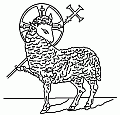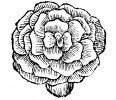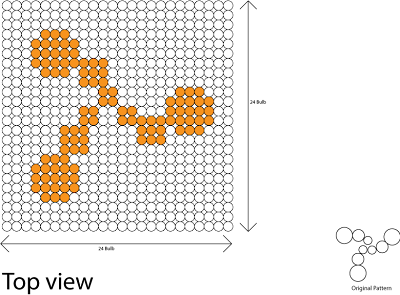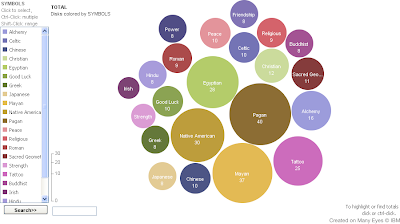Ankh
Symbol of eternal life. The gods are often seen holding an ankh to someone's lips this is considered to be an offering of "The Breath of Life". The breath you will need in the afterlife.
Amenta
This symbol represents the Underworld or Land of the Dead. Originally it meant the horizon of the sun set. Later, it became the symbol of the west bank of the Nile, where the sun set and also where the Egyptians traditionally buried their dead.
Ba
The Ba is what we might call someones personality. It would leave the body at the time of death. During the days the Ba would make itself useful, at night it would return to the tomb. At this time, it would look for the person to which it belonged. This would be the mummy, however, often the egyptians would supply the Ba with a statue in the likeness of the deceased in case the mummy was lost or damaged.
Deshret
The Red Crown. This was the crown that represented Lower Egypt (northern).
Nemes
A striped headcloth worn by Pharaohs.
Was
This is a symbol of power and dominion. The Was scepter is carried by deities as a sign of their power. It is also seen being carried by kings and later by people of lesser stature in mortuary scenes
Hedjet
The White Crown. This was the crown of Upper Egypt (southern).
Shenu
More commonly know as a cartouche. The shape represents a loop of rope in which a name is written. A protector of that name.
Uraeus
The cobra is an emblem of Lower Egypt. It is associated with the king, and kingdom of Lower Egypt. It is also associated with the sun and with many deities. The cobra represented the "fiery eye of Re", in which two uraei can be seen on either side of a winged solar disk. Starting in Middle Kingdom The uraeus appears as a symbol worn on the crown or headdress of royalty. It is used as a protective symbol, the Egyptians believed that the cobra would spit fire at any approaching enemies.
Maat
Represents truth, justice, morality and balance. Deities are often seen standing on this symbol, as if standing on a foundation of Maat.
Scarab
Called the dung beetle because of its practice of rolling a ball of dung across the ground. The Egyptians observed this behavior and equated it with the ball of the sun being rolled across the sky. They confused this balled food source with the egg sack that the female dung beetle laid and buried in the sand. When the eggs hatched the dung beetles would seem to appear from nowhere, making it a symbol of spontaneous creation. In this role it was associated with the sunrise. Khepri was the scarab headed god.
Djed
It is believed that the Djed is a rendering of a human backbone. It represents stability and strength. It was originally associated with the creation god Ptah. Himself being called the "Noble Djed". As the Osiris cults took hold it became known as the backbone of Osiris . A djed column is often painted on the bottom of coffins, where the backbone of the deceased would lay, this identified the person with the king of the underworld, Osiris. It also acts as a sign of stability for the deceased' journey into the afterlife.
Sema
This is a rendering of the lungs attached to the windpipe. As a hieroglyph this symbol represents the unification of Upper and Lower Egypt. Other symbols are often added to further illustrate unification.
Feather Of Maat
Represents truth, justice, morality and balance. It was pharaoh's job to uphold Maat. When a pharaoh died, Maat was lost and the world was flung into chaos, only the coronation of a new pharaoh could restore Maat.
Flail and Crook
A symbol of royalty, majesty and dominion.
Primordial Hill
The Egyptians believed that during creation this hill rose out of the sea of chaos to create dry land. The idea of this hill rising had a profound effect on the egyptians, being used as every thing from temple layouts to the possible inspiration behind the pyramids.
Shen
A loop of rope that has no beginning and no end, it symbolized eternity. The sun disk is often depicted in the center of it. The shen also seems to be a symbol of protection. It is often seen being clutched by deities in bird form, Horus the falcon, Mut the vulture. Hovering over Pharaohs head with their wings outstretched in a gesture of protection. The word shen comes from the word "shenu" which means "encircle," and in its elongated form became the cartouche which surrounded the king's name.
Udjat
The sound eye of Horus. Symbolizes healing and protection.
Ka
The ka is usually translated as "soul" or "spirit" The ka came into existence when an individual was born. It was believed that the ram-headed god Khnum crafted the ka on his potter's wheel at a persons birth. It was thought that when someone died they "met their ka". A persons ka would live on after their body had died. Some tombs included model houses as the ka needed a place to live. Offerings of food and drink would be left at the tomb entrance so the ka could eat and drink.
Winged Solar Disk
This is a form that the god Horus Behudety (Horus of Edfu) takes in his battles with Seth. The god Thoth used his magic to turn Horus into a sun-disk with splendid outstretched wings. The goddesses Nekhbet and Uazet in the form of uraeus snakes joined him at his side.
Tiet
The exact origin of this symbol is unknown. In many respects it resembles an ankh except that its arms curve down. Its meaning is also reminiscent of the ankh, it is often translated to mean welfare or life. As early as the Third Dynasty we find the tiet being used as decoration when it appears with both the ankh and the djed column, and later with the was scepter. The tiet is associated with Isis and is often called "the knot of Isis" or "the blood of Isis." It seems to be called "the knot of Isis" because it resembles a knot used to secure the garments that the gods wore. The meaning of "the blood of Isis" is more obscured but it was often used as a funerary amulet made of a red stone or glass. In the Late Period the sign was associated with the goddesses Nephthys, Hathor, and Nut as well as with Isis. In all these cases it seems to represent the ideas of resurrection and eternal life.
Djew
Which means mountain, the symbol suggests two peaks with the Nile valley in the middle. The Egyptians believed that there was a cosmic mountain range that held up the heavens. This mountain range had two peaks, the western peak was called Manu, while the eastern peak was called Bakhu. It was on these peaks that heaven rested. Each peak of this mountain chain was guarded by a lion deity, who's job it was to protect the sun as it rose and set. The mountain was also a symbol of the tomb and the afterlife, probably because most Egyptian tombs were located in the mountainous land bordering the Nile valley. In some texts we find Anubis, the gaurdian of the tomb being referred to as "He who is upon his mountain." Sometimes we find Hathor takeing on the attributes of a deity of the afterlife, at this time she is called "Mistress of the Necropolis." She is rendered as the head of a cow protruding from a mountainside.
Atef
The atef crown was worn by Osiris. It is made up of the white crown of Upper Egypt and the red feathers are representative of Busiris, Osiris's cult center in the Delta.
Pshent
The Double Crown, the red crown and the white crown put together to represent a unified Egypt. Although Egypt was not always a unified nation it was stronger that way.Therefore unification was desirable. Narmer (Menes), the founder of the First Dynasty around 3100 B.C., was the first man recorded wearing this crown.
Sesen
A Lotus Flower. This is a symbol of the sun, of creation and rebirth. Because at night the flower closes and sinks underwater, at dawn it rises and opens again. According to one creation myth it was a giant lotus which first rose out of the watery chaos at the beginning of time. From this giant lotus the sun itself rose on the first day. A symbol of Upper Egypt
Khet
This symbol represents a lamp or brazier on a stand from which a flame emerges. Fire was embodied in the sun and in its symbol the uraeus which spit fire. Fire also plays a part in the Egyptian concept of the underworld. There is one terrifying aspect of the underworld which is similar to the christians concept of hell. Most egyptians would like to avoid this place with its fiery lakes and rivers that are inhabited by fire demons.
Leb
This symbol represents a heart. The Egyptian believed the heart was the center of all consciousness, even the center of life itself. When someone died it was said that their "heart has departed." It was the only organ that was not removed from the body during mummification. In the Book of the dead, it was the heart that was weighed against the feather of Maat to see if an individual was worthy of joining Osiris in the afterlife.
Nebu
This symbol represents gold which was considered a divine metal, it was thought to be the flesh of the gods. Its polished surface was related to the brilliance of the sun. Gold was important to the afterlife as it represents aspects of immortality. By the New Kingdom, the royal burial chamber was called the "House of Gold."

















































